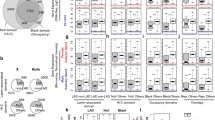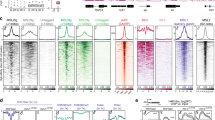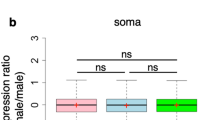Abstract
The reinverted In(1)BM 2 strain of Drosophila melanogaster alter the global architecture of the male X chromosome in ~30 % salivary nuclei, while rest of the nuclei show a perfectly normal haplo-X morphology. We show that, in the aberrant morphology of male X chromosome bearing nuclei, the chromocenter was grossly abnormal, exhibiting either loose morphology or reduced in size. Rearing flies at lower temperature (16 °C) enhanced both frequency and severity of variegated phenotype in the X chromosome and chromocenter. In variegated X chromosome, many intercalary heterochromatic sites showed cytologically visible link (ectopic pairing) at higher frequencies than the X chromosome of Oregon R males. When duplication for the segment 18A-20F, 16F-20F, 8C-20F and 1A-17F were combined with rearranged X chromosome of male, the rearranged X chromosome ceases to show variegating phenotype. Similarly, when a seperate maleless mutation (either mle 1 or mle ts—a dosage compensation regulatory gene mutation) was introduced in homozygous condition in the rearranged strain, variegated phenotypes of the male X chromosome were not only modified, bloated appearance of male X chromosome was also partially reduced. On the basis of the results, we suggest that (1) like many other re-arrangements involving pericentric heterochromatin, reinverted In(1)BM 2 X chromosome induce long-distance heterochromatin spreading into juxtraposed euchromatic sequences of the X chromosome, (2) X limited distribution of intercalary heterochromatin (either SR sequences or transposable elements bearing heterochromatic sites) function as relay elements for ‘spreading’ of heterochromatic factors to the entire X chromosome, and (3) the termination of heterochromatin spreading on the male X chromosome by different genomic context indicate that there is an inherent mechanism for movement of heterochromatin-binding proteins in the X chromosome from one class of site to another and back, for regulation of X chromosome organization.





Similar content being viewed by others
References
Ahmad K, Golic KG. Somatic reversion of chromosomal position effects in Drosophila melanogaster. Genetics. 1996;144:657–70.
Alekseyenko AA, Larschan E, Lai WR, Park PJ, Kuroda MI. High-resolution ChIP-chip analysis reveals that the Drosophila MSL complex selectively identifies active genes on the male X chromosome. Genes Dev. 2006;20:848–57.
Ashburner M. Drosophila: a laboratory handbook. 2nd ed. New York: Cold Spring Harbor Laboratory Press; 1989.
Badenhorst P, Voas M, Rebay I, Wu C. Biological functions of the ISWI chromatin remodeling complex NURF. Genes Dev. 2002;16:3186–98.
Bao X, Deng H, Johansen J, Girton J, Johansen KM. Loss-of-function alleles of the JIL-1 histone H3S10 kinase enhance position-effect-variegation at pericentric sites in Drosophila heterochromatin. Genetics. 2007;176:1355–8.
Belote JM, Lucchesi JC. Male specific lethal mutations of Drosophila melanogaster. Genetics. 1980;96:165–86.
Benos PV, Gatt MK, Ashburner M, Murphy L, Harris D, Barrell B, Ferraz C, Vidal S, Brun C, Demailles J. From sequence to chromosome. The tip of the X chromosome of D. melanogaster. Science. 2000;287:2220–2.
Bose D, Duttaray A. A case of variegation at the level of chromosome organization. Chromosoma (Berl). 1986;94:87–93.
Brennecke J, Aravin AA, Stark A, Dus M, Kellis M, Sachidanandam R, Hannon GJ. Discrete small RNA-generating loci as master regulator of transposon activity in Drosophila. Cell. 2007;128:1089–103.
Chatterjee RN. X chromosomal organisation and dosage compensation: in situ transcription of chromatin template of X chromosome hyperploids of Drosophila melanogaster. Chromosoma. 1985;91:259–66.
Chatterjee RN, Chatterjee P. Evolutionary origin of chromatin remodeling for dosage compensation: lessons from epigenetic modifications of X chromosomes in germ cells of Drosophila, C. elegans and Mammals. Nucleus. 2012;55:3–16.
Chatterjee RN, Transcription in Drosophila hydei polytene chromosome: site specific schedule of selective transcription in the X linked genes for regulation of dosage compensation. Proc Zool Soc (Cal). 1992;45:129–143.
Chatterjee RN, Dube DK, Mukherjee AS. In situ transcription analysis of chromatin template activity of the X chromosome of Drosophila following high molar NaCl treatment. Chromosoma. 1981;82:515–23.
Chatterjee RN, Chatterjee P, Pal A, Pal-Bhadra M. Drosophila simulans Lethal hybrid rescue mutation (Lhr) rescues inviable hybrids by restoring X chromosomal dosage compensation and causes flactuating, asymmetry of development. J Genetics. 2007;86:203–15.
Chen ES, Zhang K, Nicolas E, Cam HP, Zollall M, Grewal SI. Cell cycle control of centromeric repeat transcription and heterochromatin assembly. Nature. 2008;451:734–7.
Conrad T, Akhtar A. Dosage compensation in Drosophila melanogaster: epigenetic fine-tuning of chromosome-wide transcription. Nat Rev Genet. 2012;13:123–34.
Cugusi S, Kallappagoudar S, Ling H, Lucchesi JC. The Drosophila helicase MLE is implicated in functions distinct from its role in dosage compensation. Mol Cell Proteomics. 2015:14;1478–88.
Deloger M, Cavalli FM, Lerat E, Biemont C, Sagot MF, Vieira C. Identification of expressed transposable element insertions in the sequences genome of Drosophila melanogaster. Gene. 2009;439:55–62.
Deng H, Cai W, Wang C, Lerach S, Delattre M, Girton J, Johansen J, Deuring R, Fanti L, Armstrong JA, Sarte M, Papoulas O, et al. The ISWI chromatin–remodeling protein is required for gene expression and the maintenance of higher order chromatin structure in vivo. Mol Cell. 2000;5:355–65.
Deng H, Zhang W, Bao X, Martin JN, Girton J, Johansen J, Johansen KM. The jil-1 kinase regulates the structure of Drosophila polytene chromosomes. Chromosoma. 2005;114:173–82.
Deuring R, Fanti L, Armstrong JA, Sarte M, Papoulas O, et al. The ISWI chromatin-remodeling protein is required for gene expression and the maintenance of higher order chromatin structure in vivo. Mol Cell. 2000;5:355–65.
DiBartolomeis SM, Tartof KD. Jackson FR. A super family of Drosophila satellite related (SR) DNA repeats restricted to the X chromosome euchromatin. Nucleic Acids Res. 1992;20:1113–6.
Drapeau MD, Long AD. Bioinformatics and cytogenetics of unusual Drosophila melanogaster X chromosome morphology. DNA Seq. 2002;13:241–3.
Elgin SCR, Reuter G. Position-effect variegation, Heterochromatin formation and gene silencing in Drosophila. Cold Spring Harb Pers Biol. 2014;5:a017780.
Fagegaltier D, Bouge AL, Berry B, Poisot E, Sismeiro O, Coppee JY, Theodore L, Voinnet O, Antoniewski C. The endogenous siRNA pathway is involved in heterochromatin formation in Drosophila. Proc Natl Acad Sci USA. 2009;106:21258–63.
Fakunaga A, Tanaka A, Oishi K. Maleless, a recessive autosomal mutant of Drosophila melanogaster that specifically kills male zygotes. Genetics. 1975;81:135–41.
FlyBase, The Drosophila data base (2012). Available from the world wide web at the URLs http://www.morgon/Harvard.Edu and http://www.ebiacuk/flybase/.
Gallach M. Recurrent turnover of chromosome–specific satellites in Drosophila. Genome Biol Evol. 2014;6:1279–86.
Gallach M. 1.688 g/cm3 satellite-related repeats: a missing link to dosage compensation and speciation. Mol Ecol. 2015;24:4340–7.
Girton JR, Johansen KM. Chromatin structure and regulation of gene expression: the lessons of PEV in Drosophila. Adv Genet. 2008;. doi:10.1016/S0065-2660(07)00001-6.
Grewal S, Elgin SC. Transcription and RNA interference in the formation of heterochromatin. Nature. 2007;447:399–406.
Grewal S, Rice JC. Regulation of heterochromatin by histone methylation and small RNAs. Curr Opin Cell Biol. 2004;16:230238.
Gu T, Elgin SC. Maternal depletion of Piwi, a component of RNAi system impacts heterochromatin formation in Drosophila. PLoS Genet. 2013;9(9):e1003780.
Hoskins RA, Smith CD, Carlson JW, Carvalho AB, et al. Heterochromatic sequences in a Drosophila whole–genome shotgun assembly. Genome Biol. 2002;3(research 10085.1):0085.16.
Hsieu T, Brutlag D. Sequence and sequence variation within the 1.688 g/cm3 satellite DNA of Drosophila melanogaster. J Mol Biol. 1979;135:465–81.
Huag XA, Yin H, Sweeney S, Raha D, Snyder M, Lin H. A major epigenetic programming mechanism guided by pi RNAs. Dev Cell. 2013;24:502–16.
Huijser P, Hennig W, Dijkhof R. Poly (dC-dA/dG-dT) repeats in the Drosophila genome: a key function for dosage compensation and position effect? Chromosoma. 1987;95:209–15.
Johansen KM, Johansen J. Regulation of chromatin structure by histone H3S10 phosphorylation. Chromosome Res. 2006;14:393–404.
Kar A, Kulkarni-Shukla S, Dey-Guha I, Pal JK. Temperature induced alteration in the structure of the male X chromosome of the strain In(1)BM 2 (reinverted) of Drosophila. Genet Res. 2000;76:11–7.
Kaufmann BP, Iddles MK. Ectopic pairing in salivary gland chromosomes of Drosophila melanogaster I. Distribution patterns in relations to puffing. Sep De Port Acta Biol A. 1963;7:225–48.
Kellum R, Raff JW, Alberts BM. Heterochromatin protein 1 distribution during development and during cell cycle in Drosophila embryos. J Cell Sci. 1995;108:1407–18.
Kernan M, Kuroda MI, Kreber R, Baker BS. Ganetzky B.napt s a mutation affecting sodium channel activity in Drosophila is an allele of mle, a regulator of X chromosome transcription. Cell. 1991;66:949–59.
Kulkarni-Shukla S, Barge AP, Vartak RS, Kar A. Cold-induced alteration in the global structure of the male sex chromosome of In(1)BM 2 (reinverted) of Drosophila melanogaster is associated with increased acetylation of histone 4 at lysine 16. J Genetics. 2008;87:235–40.
Kuroda MI, Kernan MJ, Kreber R, Ganetzky B, Baker BS. The maleless protein associates with the X chromosome to regulate dosage compensation in Drosophila. Cell. 1991;66:935–47.
Lakhotia SC Mishra A. Functional organization of polytene X chromosome in two X chromosome inversion carrying larvae of Drosophila melanogaster reared at 24 or at 10°C. Ind J Exptl Biol. 1982;20:643–51.
Lee CG, Chang KA, Kuroda MI, Hurwitz J. The NTPase/helicase activities of Drosophila maleless, an essential factor in dosage compensation. EMBO J. 1997;16:2671–81.
Lei EP, Corces VG. RNA interference machinery influences the nuclear organization of a chromatin insulator. Nat Genet. 2006;38:936–41.
Lindslay DL, Grell. EH. Genetic variation of Drosophila melanogaster. Pubis. Carnegie Inst. Wash. No. 627, 1968.
Lindsley DL, Zimm GG. The genome of Drosophila melanogaster. New York: Academic Press; 1992.
Lohe AR, Hilliker AJ, Roberts PA. Mapping simple repeated DNA sequences in heterochromatin of Drosophila melanogaster. Genetics. 1993;134:1149–74.
Lowenhaupt K, Rich A, Pardue ML. Non-random distribution of mono- and dinucleotide repeats in Drosophila chromosomes: correlations with dosage compensation, heterochromatin and recombination. Mol Cell Biol. 1989;9:1173–82.
Lucchesi JC, Kuroda M. Dosage compensation in Drosophila. Cold Spring Harb Pers Biol. 2015;1: 7 pii 7:a019398.
Lucchesi JC, Kelley WG, Panning B. Chromatin remodeling and dosage compensation. Annu Rev Genet. 2005;39:615–51.
Malone CD, Hannon GJ. Small RNAs as guardians of the genome. Cell. 2009;136:656–68.
Mantinez-Balbas MA, Dey A, Rabindran SK, Ozato K, Wu C. Displacement of sequence specific transcription factors from mitotic chromatin. Cell. 1995;83:29–38.
Mazumdar D, Ghosh M, Das M, Mukherjee AS. Extra hyperactivity of the X-chromosome in spontaneously occurring mosaic salivary glands of Drosophila. Cell Chromos Newslett. 1978;1:8–12.
Menon DU, Meller VH. A role for siRNA in X chromosome dosage compensation in Drosophila melanogaster. Genetics. 2012;191:1023–8.
Menon DU, Coarfa C, Xiao W, Gunaratnec PH, Meller VH. siRNAs from an X-linked satellite repeat promote X-chromosome recognition in Drosophila melanogaster. Proc Nat Acad Sci USA. 2014;111:16460–5.
Moore GD, Sinclair DA, Grigliatti TA. Histone gene multiplicity and position effect variegation in Drosophila melanogaster. Genetics. 1983;105:327–44.
Mukherjee AS, Ghosh M. A different level of X-chromosomal transcription in an In (1) BM2 (reinverted) strain and its hyperploid derivatives resolves an X-coded regulatory activity for dosage compensation in Drosophila. Genet Res. 1986;48:65–75.
Pai CY, Lei EP, Ghosh D, Corces VG. The centrosomal protein CP190 is a component of the gypsy chromatin insulator. Mol Cell. 2004;16:737–48.
Pal-Bhadra M, Leibovitch BA, Gandhi SG, Rao M, Bhadra U, Birchler JA, Elgin SC. Heterochromatic silencing and HP1 localization in Drosophila are dependent on the RNAi machinery. Science. 2004;303:669–72.
Panshin IB. Cytogenic nature of position effect of genes white (mottled) and cubitus interuptus. Biol Zh. 1938;7:837–68.
Pardue ML, Lowenhaupt K, Rich A, Nordheim A. (dC-dA)n. (dG-dT)n sequences have evolutionary conserved chromosomal locations in Drosophila with implications for roles in chromosome structure and function. EMBO J. 1987;6:1781–9.
Platero JC, Csink AK, Quintanilla A, Henikaff S. Changes in chromosomal localization of heterochromatin binding proteins during the cell cycle in Drosophila. J Cell Biol. 1998;140:1297–306.
Rangan P, Malone CD, Navarro C, Newbold SP, Hayes PS, Sachidanandam R, Hannon GJ, Lehmann R. Pi RNA production requires heterochromatin formation in Drosophila. Curr Biol. 2011;21:1373–9.
Riddle NC, Elgin SCR. The dot chromosome of Drosophila: in sight into chromatin states and their change over evolutionary time. Chromosome Res. 2008;14:405–16.
Satyaki PRV, Cuykendall TN, Wie KHC, Brideau NJ, Kwak H, Aruna S, Ferree PM, Ji S, Barbash DA. The Hmr and Lhr hybrid incompatibility genes suppress a broad range of heterochromatic repeats. PLoS Genet. 2014;10:E1004240.
Senti KA Brennecke J. The pi pathway: a fly’s perspective on the guardian of the genome. Trends Genet. 2010;26:499–509.
Sentmanat MF Elgin SC R. Ectopic assembly of heterochromatin in Drosophila melanogaster triggered by transposable elements. Proc Natl Acad Sci USA. 2012;109:14104–9.
Seum C, Delattre M, Spierer A, Spierer P. Ectopic HP1 promotes chromosome loops and variegated silencing in Drosophila. EMBO J. 2001;20:812–8.
Smith CD, Shu S, Mungall CJ, Karpen GH. The release 5.1 annotation of Drosophila melanogaster heterochromatin. Science. 2007;316:1586–91.
Spierer A, Seum C, Delattre M, Spierer P. Loss of the modifiers of variegation Su(var)3-7 or HP1 impacts male X polytene chromosome morphology and dosage compensation. J Cell Sci. 2005;118:5047–57.
Spierer A, Begeot F, Spierer P, Delattre M. SU(VAR) 3-7 links heterochromatin and dosage compensation in Drosophila. PLoS Genet. 2008;2008:e1000066.
Steinemann M, Steinemann S. Degenerating Y chromosome of Drosophila miranda: a trap for retrotransposons. Proc Natl Acad Sci USA. 1992;89:7591–5.
Steinemann M, Steinemann S, Turner BM. Evolution of dosage compensation. Chromosome Res. 1996;4:1–6.
Stewart BR, Merrium JR. Segmental aneuploidy and enzyme activity as a method for cytogenetic localization of Drosophila melanogaster. Genetics. 1974;76:301–9.
Sun FL, Cuaycong MH. Elgin SCR Long-range nucleosome ordering is associated with gene silencing in Drosophila melanogaster pericentric heterochromatin. Mol Cell Biol. 2001;21:2867–79.
Sun X, Wahlstrom J, Karpen G. Molecular structure of a functional centromere. Cell. 1997;91:1007–19.
Swaminathan J, Baxter EL, Corces VG. The role of histone H2Av variant replacement and histone H4 acetylation in the establishment of Drosophila heterochromatin. Gene Dev. 2005;19:65–76.
Tsukiyama T, Daniel C, Tamkun J, Wu C. ISWI, a member of SWI2/SNF2 ATPase family encodes the 140 kDa subunit of the nucleosome remodeling factor. Cell. 1995;83:102–1026.
Wallrah LL, SCR Elgin. Position effect variegation in Drosophila is associated with an altered chromatin structure. Genes Dev. 1995;9:1263–77.
Wang SH, Elgin SCR. Drosophila piwi functions down stream of pi-RNA production meadiating a chromatin based transposon silencing mechanism in female germ line. Proc Natl Acad Sci USA. 2011;108:21164–9.
Wang YW, Zhang Y, Jin J, Johansen J, Johansen KM. The JIL-1 tandem kinase mediates histone H3 phosphorylation and is required for maintenance of chromatin structure in Drosophila. Cell. 2001;105:433–43.
Wang C, Cai W, Li Y, Deng H, Bao X, Girton J, Johansen J, Johansen KM. The epigenetic H3S10 phosphorylation mark isrequired for counteracting heterochromatic spreading and gene silencing in Drosophila melanogaster. J Cell Sci. 2011;124:4309–17.
Waring GL, Pollack JC. Cloning and characterization of a dispersed multicopy X chromosome sequence in Drosophila melanogaster. Proc Natl Acad Sci USA. 1987;84:2843–7.
Weiler KS, Wakimoto BT. Heterochromatin and gene expression in Drosophila. Annu Rev Genet. 1995;29:577–605.
Zhang W, Deng H, Bao X, Lerach S, Girton J, et al. The JIL-1 histone H3S10 kinase regulates dimethyl H3K9 modifications and heterochromatic spreading in Drosophila. Development. 2006;133:229–35.
Zhimulev IF. Morphology structure of polytene chromosomes. Adv Genet. 1996;34:1–497.
Zhimulev IF. Polytene chromosomes, heterochromatin, and position effect variegation. Adv Genet. 1998;37:1–566.
Zhimulev IF, Belyaeva ES, Fomina OV, Protopopov MO, Bolshkov VN. Cytogenetic and molecular aspects of position effect variegation in Drosophila melanogaster. Chromosoma. 1986;94:492–504.
Acknowledgments
We are thankful to Bloomington Drosophila stock center, for generously sending the Drosophila stocks. The work has been supported by UGC Emeritus Fellowship [Sanction No. F. 6-6/2015-17/EMERITUS-2015-17-GEN-5478(SA-II) dt.21.09.2015] to RNC.
Author information
Authors and Affiliations
Corresponding author
Ethics declarations
Conflict of interest
The authors declare that they have no conflicting interest.
Additional information
The paper is dedicated to Prof. A. K. Sharma, as inspirational and integrative leader in the field of chromosome research.
Electronic supplementary material
Below is the link to the electronic supplementary material.
Rights and permissions
About this article
Cite this article
Chatterjee, R.N., Chatterjee, R. & Ghosh, S. Heterochromatin-binding proteins regulate male X polytene chromosome morphology and dosage compensation: an evidence from a variegated rearranged strain [In (1)BM 2,(rv)] and its interactions with hyperploids and mle mutation in Drosophila melanogaster . Nucleus 59, 141–154 (2016). https://doi.org/10.1007/s13237-016-0177-0
Received:
Published:
Issue Date:
DOI: https://doi.org/10.1007/s13237-016-0177-0




